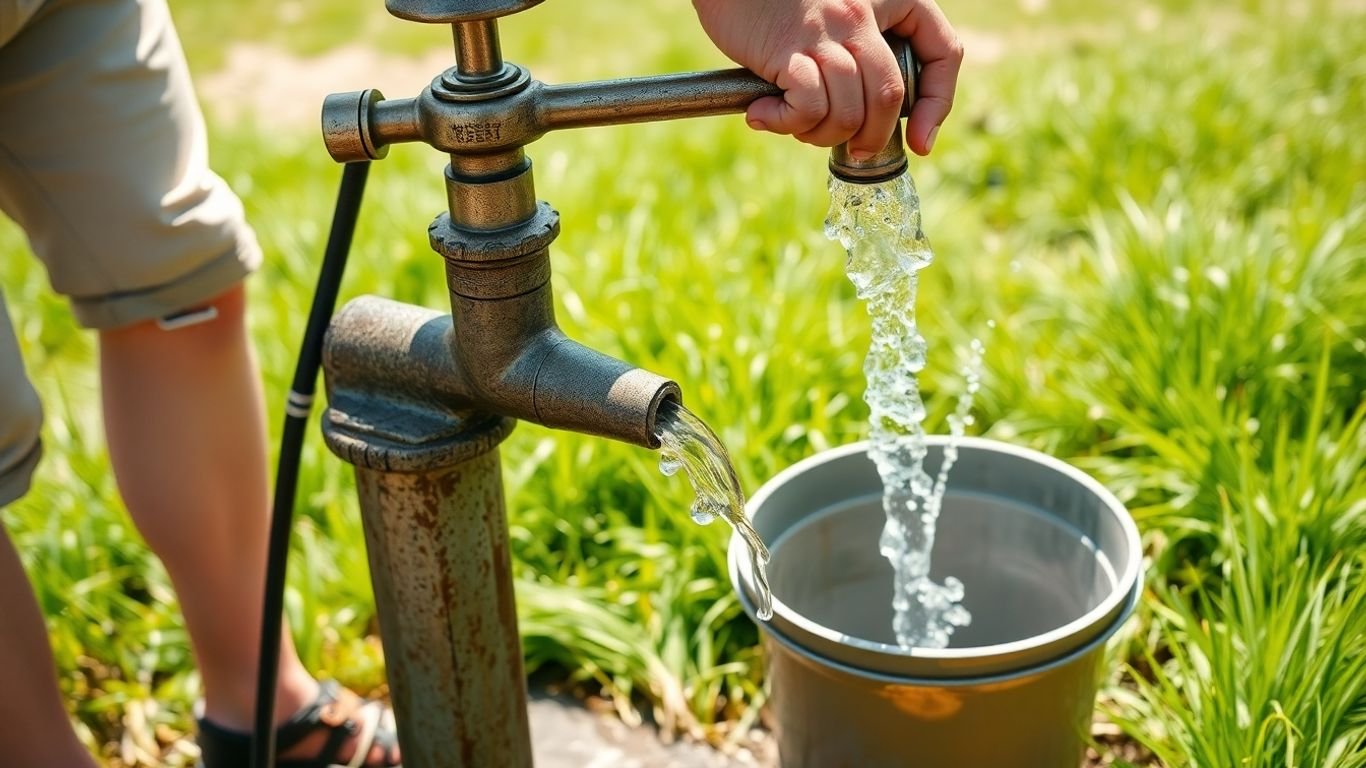How to Pump Well Water Without Electricity

Many homes rely on private groundwater wells for their water supply. But what happens when the electricity goes out? Your well pump stops working, leaving you without access to that vital resource. This might sound like a big problem, but there are actually several ways to get your well water to the surface without power. Planning ahead is key, and knowing your options can make a huge difference when you need water the most.
Key Takeaways
- Understand your well system, including pump type and power needs, before an emergency strikes.
- Manual hand pumps offer a reliable, non-electric way to access well water, with options for both shallow and deep wells.
- Generators can power electric well pumps, but ensure the generator’s power output matches your pump’s requirements (110V vs. 220V).
- Simple methods like a well bucket can provide emergency water access, especially if you can’t afford more complex solutions.
- Solar-powered well pumps are a sustainable, low-maintenance alternative for continuous water access without relying on the grid.
Understanding Your Well Water Source

If you live outside of a municipal water system, your well is likely your main source of water. It’s a pretty amazing thing, really – a direct line to the groundwater beneath your property. But when the power goes out, that reliable flow can stop dead. Understanding how your well works and what kind of system you have is the first step to figuring out how to get water when the grid is down.
Private Groundwater Wells
Most homes not connected to city water rely on private groundwater wells. These are essentially holes drilled or dug deep into the earth to tap into underground water sources called aquifers. The depth and accessibility of these aquifers determine the type of well and pump system you’ll need. It’s important to know if your well is considered shallow or deep, as this impacts how water can be brought to the surface. For more on groundwater and wells, you can check out this resource on groundwater and wells.
Well Pump Systems
Your well pump is the workhorse that brings water from the aquifer up to your house. Most modern wells use electric pumps. These can be submersible pumps, located down inside the well casing, or jet pumps, usually located above ground. The pump pushes water into your home’s plumbing and also into a storage tank. This tank, often called a pressure tank, holds a reserve of water. Even without electricity, you might have a small amount of water available from this tank, but it usually runs out pretty fast.
Water Storage Tanks
Water storage tanks, or pressure tanks, are a key part of most well systems. They store a supply of water under pressure. When you turn on a faucet, the pressure in the tank forces water out. This system means your pump doesn’t have to run every single time you need a little bit of water, saving energy and wear and tear. However, when the electricity is out, the pump can’t refill the tank, so the water you have stored is all you’ll get until power is restored or you find another way to pump water.
Knowing your well’s specifics – like its depth, the type of pump you have, and the size of your storage tank – is super helpful when planning for a power outage. It’s not just about having a backup plan; it’s about having the right backup plan for your specific setup.
Manual Pumping Methods for Well Water

When the power grid goes down, your electric well pump stops working. It’s a common problem for many households that rely on private wells. But don’t panic, there are ways to get that water to the surface without electricity. Planning ahead is key, and having a manual pump system in place can be a real lifesaver.
Hand Pumps for Modern Wells
Attaching a hand pump to your existing well head is a practical backup. Some models can be installed right alongside your electric pump, so you don’t have to choose between the two. It’s important to know that hand pumps vary quite a bit. Some are only good for pulling water up a few feet, while others are designed for much deeper wells, potentially reaching down 200 feet or more. Doing your homework to find one that matches your well’s depth is a must. This kind of pump is a great way to have an off-grid water pump ready to go.
Deep Well Hand Pumps
For wells where the water level is significantly below the surface, a deep well hand pump is the way to go. These pumps work differently than their shallow-well counterparts. Instead of just a pump head, they often involve a cylinder that sits down in the water. This cylinder is connected to the pump head above by a pipe and a rod. When you work the handle, it moves the rod, which operates the cylinder to lift the water. Because the working parts are submerged, they stay wet and don’t need priming, which is a big advantage. These systems can be quite robust and are designed to lift water considerable distances.
- Consider the depth: Make sure the pump you select is rated for your well’s depth.
- Pumping action: Understand how the pump transfers your effort to lifting water.
- Materials: Look for durable materials like stainless steel for longevity.
Shallow Well Hand Pumps
If your well’s water level is relatively close to the surface, usually within about 20 feet, a shallow well hand pump is a simpler option. These pumps typically sit above ground and draw water up. They often require what’s called ‘priming’ the first time you use them, which just means pouring some water into the pump to create a seal. Without this seal, the pump can’t create the suction needed to pull water up. They are generally easier to install and maintain than deep well pumps.
Priming a shallow well pump involves filling the pump housing with water to create a seal. This is necessary because the pump relies on suction to draw water, and the seal prevents air from breaking that suction. Once primed, it should operate correctly as long as the water level is within its reach.
- Check water level: Measure the distance from the ground to the water surface.
- Priming procedure: Be prepared to add water to the pump if needed.
- Pipe length: Ensure you have enough pipe to reach the water source.
Utilizing a Generator for Well Water
When the power grid goes down, your electric well pump stops working. That’s a big problem if you rely on your well for water. But, you can get your pump running again if you have a generator. It’s not as simple as just plugging it in, though. You need to know a few things about your pump and the generator you plan to use.
Generator Power Requirements
Most modern well pumps, especially the submersible ones deep in the well, run on 220-volt power. This is the same kind of power that runs big appliances like electric ovens or clothes dryers. If your generator can supply 220 volts, you’re in good shape. However, many common portable generators only put out 110-volt power. So, if your pump needs 220 volts and your generator only provides 110, you’ll need a different solution or a more powerful generator.
Here’s a quick look at common power needs:
| Pump Type | Typical Voltage | Notes |
|---|---|---|
| Submersible Pump | 220V | Most common for deeper wells. |
| Jet Pump | 110V or 220V | Can be used for shallower wells. |
| Older Pumps | 110V | Less common now, but possible. |
Before a power outage hits, find out exactly what voltage your well pump requires. This information is usually on the pump’s data plate or in its manual. Trying to guess or hook up the wrong voltage can damage your pump or generator.
Portable Generator Limitations
While a generator can be a lifesaver, portable ones have their limits. They can be noisy, require fuel that you need to store safely, and might not be powerful enough for larger pumps. Plus, you have to be careful about how you connect it to your well system. You don’t want to accidentally send power back into the grid or create a dangerous situation.
- Fuel Storage: You’ll need a supply of gasoline, propane, or diesel, depending on your generator type. Storing fuel requires care and attention to safety regulations.
- Noise: Generators can be quite loud, which might be an issue depending on your location and neighbors.
- Power Output: Many smaller portable generators are designed for basic needs, not for running a heavy-duty well pump. You might need a larger, more expensive unit.
- Connection: Improperly connecting a generator can be dangerous. It’s best to have a qualified electrician set up a transfer switch or appropriate connection for your well pump.
If you have a 110-volt pump, a smaller generator might work. But for most submersible pumps needing 220 volts, you’ll likely need a generator with a higher wattage output. Always check the generator’s specifications against your pump’s requirements.
Low-Tech Solutions for Well Water Access
When the power goes out, your electric well pump stops working, and suddenly, you’re without water. It’s a common problem for many households that rely on private wells. While generators and solar pumps are options, sometimes you need simpler, more immediate ways to get water. These low-tech methods are great for emergencies or just for getting a bit of water when you need it without fuss.
The Well Bucket Method
This is probably the most straightforward way to get water from your well when the pump is down. It involves using a specialized bucket designed to be lowered into the well on a rope or cord. The idea is simple: lower the bucket, let it fill, and then pull it back up. The key is having a bucket that can seal itself to hold the water once you start lifting it. Many modern well buckets have a valve at the bottom that opens when it hits the water, allowing it to fill from the bottom up. When you pull it up, the valve closes, keeping the water inside. You’ll need to make sure you have enough strong cord to reach the water level and a secure way to tie it off at the top of the well so you don’t lose your bucket.
- Check your well’s diameter: Make sure the bucket you choose will fit down your specific well casing. Some are quite narrow.
- Measure your well depth: Ensure your rope or cord is long enough to reach the water and still have some slack at the top.
- Test the lifting strength: Pulling up a full bucket of water can be heavy. Make sure you have a strong rope and a way to manage the weight.
Improvising a Well Bucket
If you don’t have a proper well bucket on hand, you can often make one in a pinch. The goal is to create a container that’s heavy enough to sink and can hold water. A common DIY approach involves using a length of steel pipe, maybe two feet long, with a cap on one end. You’d then attach a strong cord to the other end. The weight of the steel pipe helps it sink, and if you can rig a simple flap or valve at the bottom, it can hold water. It might not be as efficient as a purpose-built bucket, but it can definitely get you some water when you’re in a bind. This method is a good backup to have in mind, especially if you live in a remote area and want to be prepared for power outages.
When thinking about emergency water access, it’s wise to consider the weight of a full bucket. A gallon of water weighs about 8.3 pounds. A two-gallon bucket, therefore, could weigh over 16 pounds, plus the weight of the bucket itself. Make sure your rope and your own strength can handle it.
Here’s a quick look at what you might need:
- A sturdy length of pipe (e.g., 2-foot section of 4-inch steel pipe)
- A cap for one end of the pipe
- A strong rope or cord (long enough for your well depth)
- Tools to attach the rope securely and potentially rig a simple valve or flap at the open end.
Alternative Power for Well Pumps
When the power grid goes down, your electric well pump stops working. That’s a problem, but it doesn’t mean you’re completely out of luck. There are ways to get water without relying on electricity. Think about solar power or even good old-fashioned muscle. These options can keep your water flowing, even when the lights are out.
Solar-Powered Well Pumps
Solar pumps are a pretty neat solution for getting water when you don’t have grid power. They use the sun’s energy to run the pump. It’s a clean way to get water, and once it’s set up, it doesn’t cost anything to run beyond the initial setup. This makes them a great choice for remote locations or for anyone wanting to be more self-sufficient.
Components of Solar Pump Systems
A solar pump system has a few key parts that work together. You’ve got the solar panels, which are the most visible part. Then there’s a controller that manages the power flow. And of course, the pump itself, which does the actual work of moving the water. Sometimes, you might also have batteries to store power for cloudy days or nighttime use.
Here’s a quick look at the main pieces:
- Solar Panels: These capture sunlight and turn it into electricity. The more panels you have, the more power you can generate.
- Controller: This gadget makes sure the electricity from the panels is sent to the pump correctly. It helps protect the pump from getting too much or too little power.
- Pump: This is the part that actually pulls the water up from your well. There are different types, like submersible pumps that go down into the well, or jet pumps that sit above ground.
- Batteries (Optional): If you need water when the sun isn’t shining, batteries can store the energy collected during the day. This adds complexity and cost but provides more consistent water access.
Setting up a solar pump system involves matching the pump’s needs to the solar array’s output. It’s not just about slapping some panels on a pump; you need to consider how much water you use daily and how much sunlight your location gets throughout the year. Getting this right means your pump will work reliably when you need it.
The biggest advantage of solar is its low running cost and environmental friendliness. It’s a sustainable way to access well water, especially if you’re off the grid or want to reduce your reliance on fossil fuels.
Planning and Maintenance for Well Systems
Setting up a well water system, especially one that doesn’t rely on electricity, takes some thought. It’s not just about picking a pump; you’ve got to consider how it all fits together and how you’ll keep it running smoothly. Proper planning and regular upkeep are key to having a reliable water source for years to come.
Well System Installation Considerations
Before you even think about drilling, figure out your water needs. How much water do you use daily for drinking, cooking, and hygiene? Do you have animals or a garden that need water too? Knowing this helps you choose the right size pump and storage tank. You’ll also need to check local rules and get any permits required for drilling. Finding a good spot for the well is important too – you want a place where the water table is accessible and where it’s easy to get to for maintenance. Sometimes, hiring experienced drillers and installers is the best way to make sure everything is set up safely and works efficiently. Don’t forget to test your water quality after installation to make sure it’s safe to drink.
Regular Maintenance of Well Pumps
Just like any machine, your well pump needs a little TLC to keep it working well. It’s a good idea to check the well cover regularly to make sure no dirt or critters can get in and contaminate your water. Look over the pump itself and any solar panels (if you’re using them) for any signs of wear or damage. Cleaning solar panels when they get dusty or dirty is a simple step that can really help them work better. Testing your water periodically is also a smart move for peace of mind.
Here’s a quick rundown of maintenance tasks:
- Inspect the well cap and seal for damage or gaps.
- Clean solar panels to maximize their energy output.
- Check pump connections and wiring for any issues.
- Listen for unusual noises from the pump.
- Periodically test your water quality.
Keeping your well system clean and functional is more than just a chore; it’s about safeguarding your health and ensuring a consistent water supply, especially when you’re off the grid.
Troubleshooting Well Water Issues
Sometimes, things don’t go as planned. If you notice low water pressure or no water at all, don’t panic. First, check for any obvious leaks in your plumbing. Make sure your pump is getting power – if it’s solar, check those panels and the connections. If you’re using a hand pump, ensure it’s primed correctly if it’s a shallow well type. Sometimes, the issue might be as simple as a clogged intake screen. For more complex problems, it might be time to consult the manual or call in a professional. Having a backup plan, like a stored water supply, can be a lifesaver during these times.
Wrapping Up: Staying Hydrated When the Power’s Out
So, you’ve seen that losing electricity doesn’t have to mean losing access to your well water. Whether you’re thinking about a generator, a trusty hand pump, or even a simple well bucket for those times when you just need a few gallons, there are options. It’s really about being prepared. Thinking ahead and having a backup plan means you won’t be caught off guard when the power grid goes down. A little bit of planning now can make a big difference later, ensuring you and your family have the water you need, no matter what.
Frequently Asked Questions
What is a private groundwater well?
A private groundwater well is basically a hole dug or drilled deep into the ground to reach water that’s stored underground in layers called aquifers. Instead of getting water from a city’s pipes, you get it straight from the earth. Many homes, especially in rural areas, use these wells as their main water source.
How do electric well pump systems work, and what happens during a power outage?
Electric well pump systems use a pump, usually placed at the bottom of the well, to push water up to your house. This pump needs electricity to run. When the power goes out, the pump stops working, and you won’t get any water from your well. Some systems have a storage tank that holds a small amount of water, but it runs out quickly.
What are the main types of non-electric well pumps?
There are a few main ways to get water without electricity. You can use a hand pump, which you operate by moving a handle. Another option is a well bucket, a simple container you lower into the well to scoop up water. Solar-powered pumps are also available, using sunlight to run the pump.
What’s the difference between deep well and shallow well hand pumps?
Shallow well hand pumps are designed for wells where the water is close to the surface, usually within about 20 feet. Deep well hand pumps are more powerful and have a special part called a cylinder that sits underwater, allowing them to pull water from much deeper down. Deep well pumps often don’t need to be ‘primed,’ which means you don’t have to add water to get them started.
Are generators a good way to power a well pump during an outage?
Generators can work, but they have downsides. Most portable generators only provide 110-volt power, while many well pumps, especially deep ones, need 220-volt power. You’d need a powerful generator specifically designed for that higher voltage, and you also have to worry about fuel and maintenance. They can also be noisy and expensive.
What is the simplest, lowest-cost way to get water from a well without power?
The simplest and often cheapest method is using a well bucket. This is a long, narrow container, sometimes just a metal pipe with a cap, that you lower into the well on a rope. It has a valve at the bottom that lets water in but keeps it from spilling out when you pull it up. It’s a basic but effective way to get water when you have no other options.






![[Jasmine Crockett]'s face, showing a change in expression.](https://countrybrief.com/wp-content/uploads/2025/09/thumbnail-8-768x432.jpeg)